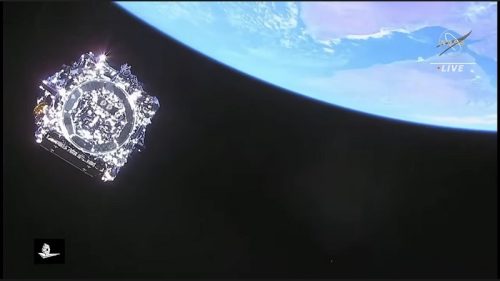Bruce taking me for a walk at the dog park – I like to see things that remind me of warmer days when we get to this point in Winter.

Some Chicago Boyz know each other from student days at the University of Chicago. Others are Chicago boys in spirit. The blog name is also intended as a good-humored gesture of admiration for distinguished Chicago School economists and fellow travelers.
Bruce taking me for a walk at the dog park – I like to see things that remind me of warmer days when we get to this point in Winter.


This is being described as “humanity’s last view of the JWST.”

I expect imaging, and even direct viewing, of the James Webb Space Telescope from terrestrial telescopes to become a popular amateur astronomical activity in the summer of 2022. Here is why:
A full Moon has apparent magnitude -12.7. This is the result of its distance of ≈380,000 kilometers, its effective area (a circle of radius ≈1,700 kilometers) of ≈9.1 million km ², and its albedo of ≈0.12.
The JWST will be at ~4 LD, the effective area of its sunshield will be ≈830 m ², and its albedo will be very close to 1.
Its distance makes it 16 times as faint, its effective area makes it 11 billion times as faint, and its albedo makes it 8.3 times as bright. Multiplying all these together yields a factor of 21 billion.
The magnitude scale is measured in increments of âµâˆš100 ≈ 2.5, such that each 5 steps downward is 100 times brighter. Venus, which can reach an apparent magnitude of -4.7, is nearly 100 times brighter than Arcturus (α Boötis), at -0.05. The stars in the Big Dipper and in Orion’s Belt are around magnitude +2.
The limits of my experience are the Sun, apparent magnitude -26.7, and some of the fainter Pleiades, magnitude +6.5 or even fainter—note that this takes not only very clear, dark, moonless skies, but also an hour and a half or more of no artificial light whatsoever for excellent dark adaptation, and probably eyes younger than mine are now (I am recalling an incident from my 30s). That’s a factor of almost 20 trillion.
Anyway, doing the math, something 21 billion times fainter than a full Moon has an apparent magnitude of +13.1.
Every amateur astronomer reading this just went huh. Easy.
Taking the usual limiting magnitude of the unaided eye to be exactly +6 and the effective aperture of the human pupil to be 7mm, less than 200mm of primary lens or mirror diameter would be enough. In the real world, it’s going to be harder than that … but I found Pluto in my 333mm f/4.5 Newtonian at magnitude +13.8 or thereabouts during a Texas Star Party in the 1990s.
The challenge will be figuring out which thirteenth-magnitude speck in the field of view is actually the JWST, but one thing’s going to make it a lot easier: it won’t be moving with the starry background. Its motion will essentially be at the solar rate, ~1 °/day. That’s 2 ½ arc-minutes per hour, or 2 ½ arc-seconds per minute. A pair of images taken even a few minutes apart will pop it out, much like the discovery images of Pluto in 1930.
UPDATE (12/31): en route